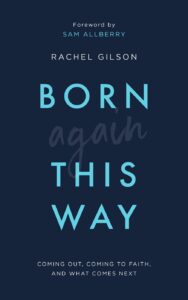coming out, coming to faith, and what comes next.
Rachel Gilson
The Good Book Company, 2020.

I was nervous before reading this book. I feared it would be someone writing how becoming a born-again Christian erases unwanted same-sex attraction. This is not that book. Rachel Gilson writes:
“For men and women who grew up in the church in the 1980s, 90s, and beyond, same-sex attraction was largely cast as utter perversion … So if you experienced same-sex attraction but loved Jesus, you usually kept dead quiet or actively sought to “pray the gay away” …
… what is known as “reparative therapy,” a program which aims to “create” heterosexuality, is a false gospel – it makes promises God does not.” Page 137.
Rachel says that church should be a place where people feel free to talk about their sexuality:
“many people who grew up in the church did not find it to be a safe place in which to discuss same-sex attraction, let alone admit to experiencing it.
This should not be.” Page 129.
She argues that there are two ends of the spectrum in churches, and both are wrong:
“On one side, we may be in a church that is dangerously lax or even outright disobedient when it comes to biblical sexuality. How can we receive strength for our fight against our temptations if our elders and our siblings think we’re crazy for trying? …
On the other side, we may be in a church family that still believes in dangerous things like reparative or conversion therapy – an outworking of the misguided belief that sexual holiness is equated to heterosexuality. … Some Christians still consider those who experience same-sex attraction as somehow “less than,” or inherently dangerous or untrustworthy.” Page 83.
Rachel explains her purpose in writing:
“This book is my story. It’s just one among many, and it’s not intended to be weaponized against anyone else or used as a pawn. But my hope is that my account of coming out, coming to faith, and what came next will be a refreshment to you on your own journey.” Page 12.
As a teenager, she had had sexual experiences with both genders and concluded that she was gay. She assumed that being gay was incompatible with being a Christian:
“Each new encounter strengthened my conviction that my sexuality was at home with females, and in exile with males. …
By the end of high school, I was convinced that everything central to my identity was opposed to everything central to Christianity …
I was determined to marry my girlfriend” Page 18.
That relationship broke up, and while Rachel was at Yale university, she became a Christian:
“none of this made a dent on my same-sex attractions.” Page 22.
“The only two people I knew at Yale who identified as Christians were two girls who were dating each other, and one was training to be a Lutheran minister. I went to them. They assured me that the conflict between Christianity and same-sex romance was based on a traditional misunderstanding and sent me away with a packet of information that would set the biblical record straight. … However, when I looked up the Bible verses discussed, it didn’t square. The interpretations looked like a misreading of what was plain in the Bible text: that same-gender sexual contact was forbidden by God.” Page 20.
From reading the Bible she challenges the assumption that natural inclinations are created by God and therefore good. Discussing Ephesians chapter 2, she writes:
“Natural doesn’t automatically mean good … We may well have been “born this way,” but every one of us was born sinful.” Page 47.
We can’t switch off our desires, but in drawing nearer to Christ, the Holy Spirit can refocus us:
“When we believed Christ, we received the Holy Spirit (Ephesians 1:13-14), and God promises that part of the fruit of the Spirit is self-control (Galatians 5:23). We don’t produce self-control through our own willpower or good intentions. … It is fruit, coming forth from our relationship with God.” Page 64.
Later in Rachel’s account she gets married to a man. I was worried to read this, because it might be turning the clock back to those who thought getting married might change their sexuality, resulting in a miserable marriage.
Rachel is alert to these problems. She writes:
“you can’t enter into marriage with either of you hoping that it will erase same-sex attraction. Yes, change can happen. But it is never promised. If this is a motivation for either person, you may experience bitter disappointment. It is never good for us to assume that what we want is what God provides.” Page 121.
She didn’t have the same level of sexual attraction to her boyfriend as she had had for previous girlfriends:
“Whereas the other feeling was overpowering and explosive, the feeling in me that was growing towards him felt much more vulnerable … I worried whether something like that could possibly fuel a marriage.” Page 96.
Over time:
“my affections grew. … I had a strong sense which seemed to be from the Lord that I should marry Andrew. …
I didn’t marry to make myself straight …
just as beautiful and possible is the life dedicated to God in singleness” Page 98.
Rachel is also realistic about marriage:
“all marriages face some levels and seasons of sexual dysfunction. Couples in which one person is same-sex-attracted might assume that any sexual problem they experience stems from this attractional pattern. That may be the case – or … For example, many couples face issues with unequal sexual desire.” Page 120.
“Trusting the Lord doesn’t always mean you end up married. …
Nor does trusting in the Lord mean that if he leads you into marriage, it will be cheery and free of trouble. Marriage is not the goal of the Christian life or its promised rest. Jesus is the goal; Jesus is our rest.” Page 125.
February 2025
Adrian Vincent